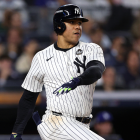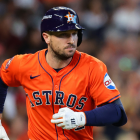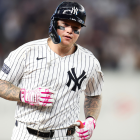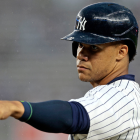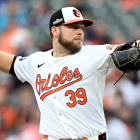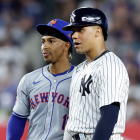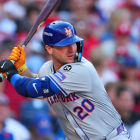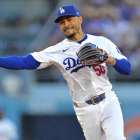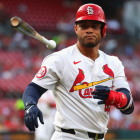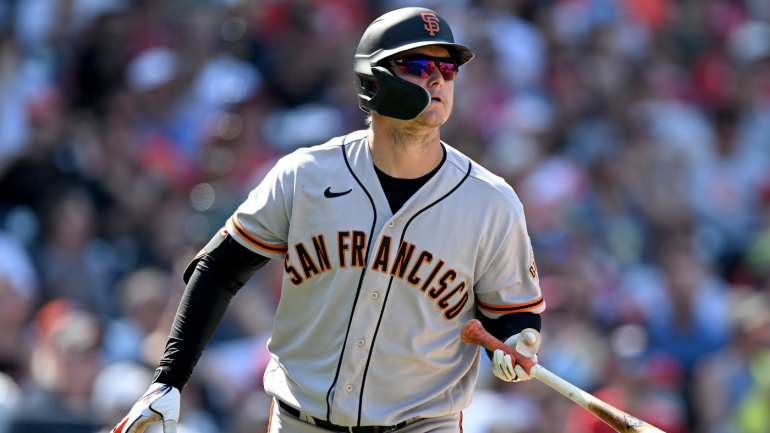
The designated hitter rule, in which pitchers are not forced to humiliate themselves at the plate, is now a permanent presence in Major League Baseball. The DH has of course been in force in the American League since 1973, and the National League used it during the COVID-abbreviated 2020 season. And now, thanks to the latest collective bargaining agreement, the universal DH is in force across both leagues on a permanent basis.
We bring up this obvious bit of information on this day because this day marks the six-year anniversary of this particular unlikeliest of lightning strikes:
That is retired moundsman Bartolo Colon on the occasion of his first and only major-league home run. Colon for his career as a "hitter" had an OPS of .199 – yes, OPS of .199 – so what you see above can be characterized as rare in the extreme. The point revisiting this is that, it says here, no amount of such whimsy at the plate can make up for the miserable experience of watching pitchers undertake something they were not selected for and at which they have no particular faculties.
Fellow retired moundsman Cliff Lee, your thoughts?
Precisely. As for Mr. Colon, that his home run happened and is forever available to us via the magic of color television means that, yes, it's fine for pitchers never to bat again – the peerless Shohei Ohtani excepted. You'll further note that baseball has continued to survive, draw ears and eyeballs to broadcasts, and even sell tickets despite the presence of the DH in the august and hallowed senior circuit. If any arch traditionalists have sworn off the game, then they're too small in number to notice.
In any event, let's use this occasion to reflect upon the first month or so of the universal DH as a permanent presence in MLB. We'll do so via the timeless framing device of half-considered "takeaways." Let us proceed.
National League DHs definitely aren't hitting yet
Let's jump right into the relevant digits, current as of Friday morning. Here's how each NL position ranks this season in terms of OPS at the plate:
| Position | 2022 OPS (NL only) |
|---|---|
First base | .787 |
Third base | .766 |
Left field | .736 |
Right field | .676 |
Second base | .676 |
Center field | .651 |
Shortstop | .650 |
Catcher | .641 |
Designated hitter | .630 |
As you can see NL DHs are struggling badly so far in 2022. The DH is by definition a "bat only" position, which means DHs should not be hitting south of premium defensive positions like shortstop and catcher. Yet here we are. It's also worth noting that AL DHs this season have an OPS of .674, so they're faring more in line with expectations.
To be sure, the small sample size could be at work – again, we're only a month in – and there could be an adjustment period for some NL DHs when it comes to adapting to the role. There is, after all, an established DH penalty at work.
Combine NL and AL DHs, and their seasonal OPS of .660 would be the lowest ever for the position/role. That said, the league as a whole is struggling to produce on offense, in large measure because of the baseball itself. The current MLB OPS of .679 if it holds up will be the lowest such mark since 1972. That league context helps explain part of the DH struggles thus far.
But it's still better than what pitchers would've done
Don't despair too much. Even at the current historical depths DHs are doing much more than pitchers ever did at the plate. In 2021, their last season of inflicting their hitting "skills" upon us, pitchers had an OPS of .293 or less than half of what NL DHs have done this season. Also bear in mind again that offense overall was up in 2021 relative to this year. Pitchers at their very peak, at least in non-adjusted terms, put up an OPS of .544 in 1930. That, again, is well shy of what NL DHs this season have done in a down year for hitters. The 1930 season, in contrast, was perhaps the best ever for hitters.
As dreary as offensive outputs have been thus far in 2022, imagine what they'd look like if pitchers were still compelled to stand in the box with an implement on their shoulders. Perish the thought.
The sac bunt has become much less common
In addition to no longer having to watch pitchers take full swings, we also no longer have to watch them plop down groaningly obvious sac-bunt attempts. The good news is that the Most Boring Play In Baseball has largely been vaporized by the universal DH. It still happens from time to time, but it's much less frequent than it once was.
This season, for instance, teams have laid down sac bunts 55 times in 762 team games. That comes to one sac bunt every 13.9 team games. By comparison, last season MLB endured 766 sac bunts, or one every 6.34 team games. Sac bunts are now roughly half as common as they were last season when pitchers still ambled to the plate. Consider this another merit of the universal DH.
For those of you pining away for NL baseball of yore, be consoled in the knowledge that there's nothing stopping Bartolo Colon from cold-calling teams and asking if they need help at DH. If Ohtani can do it, then, well, you know.









